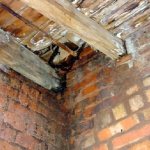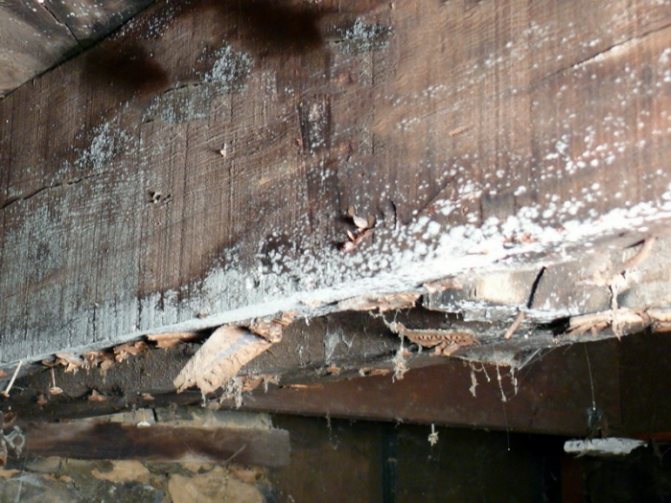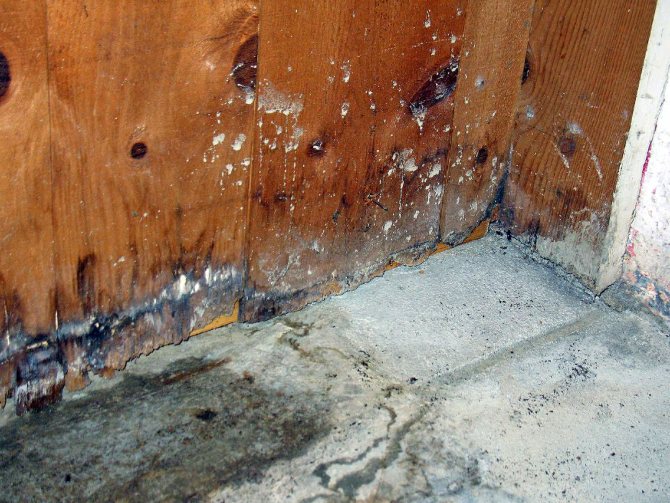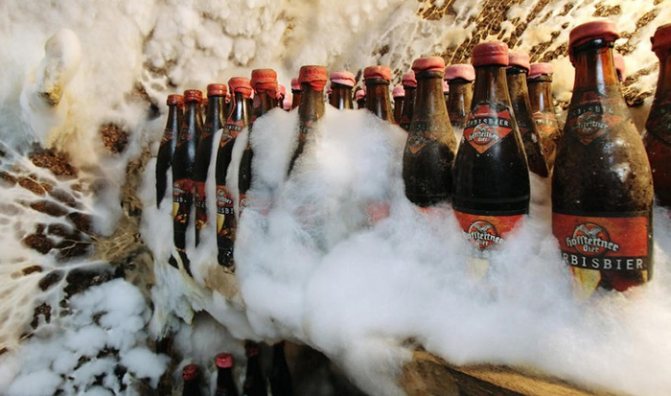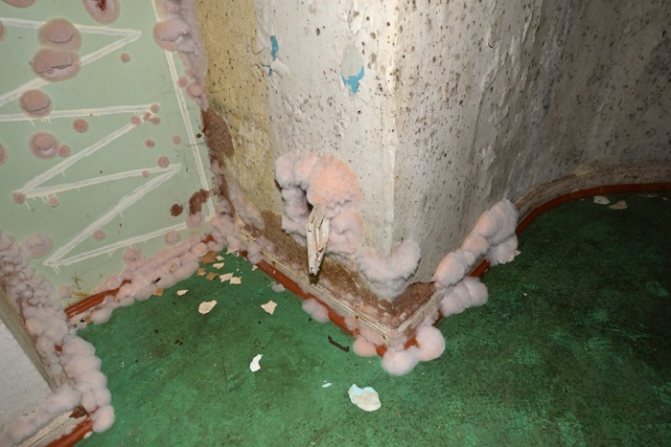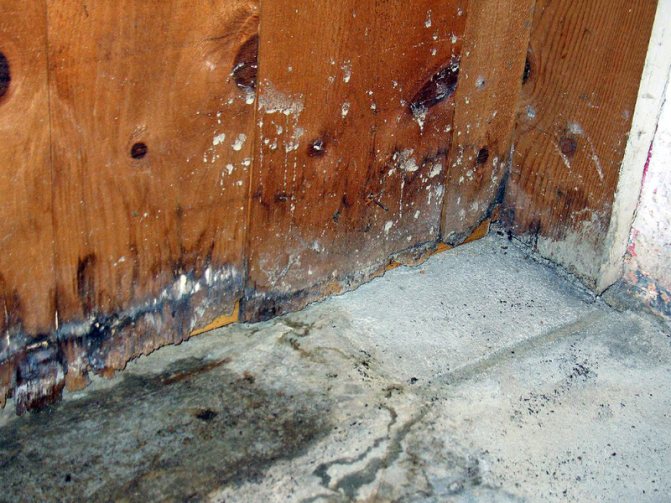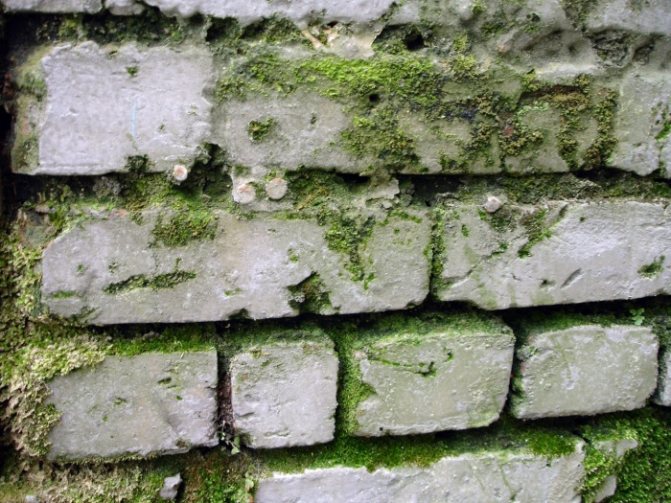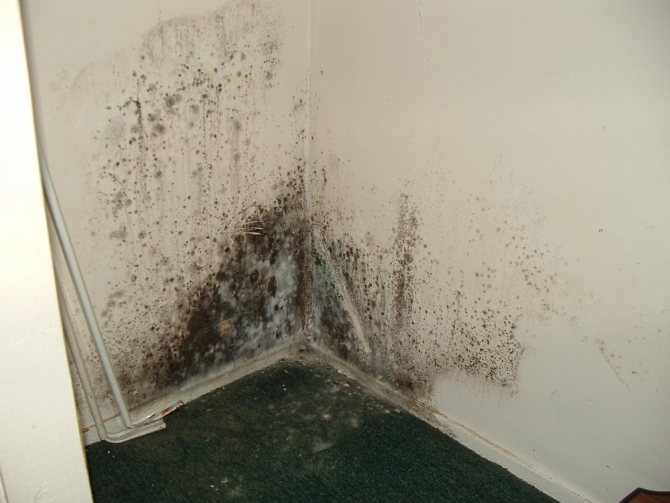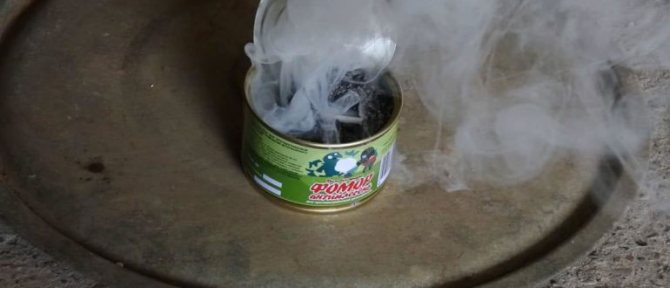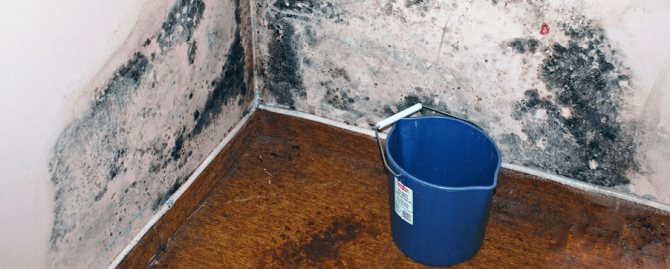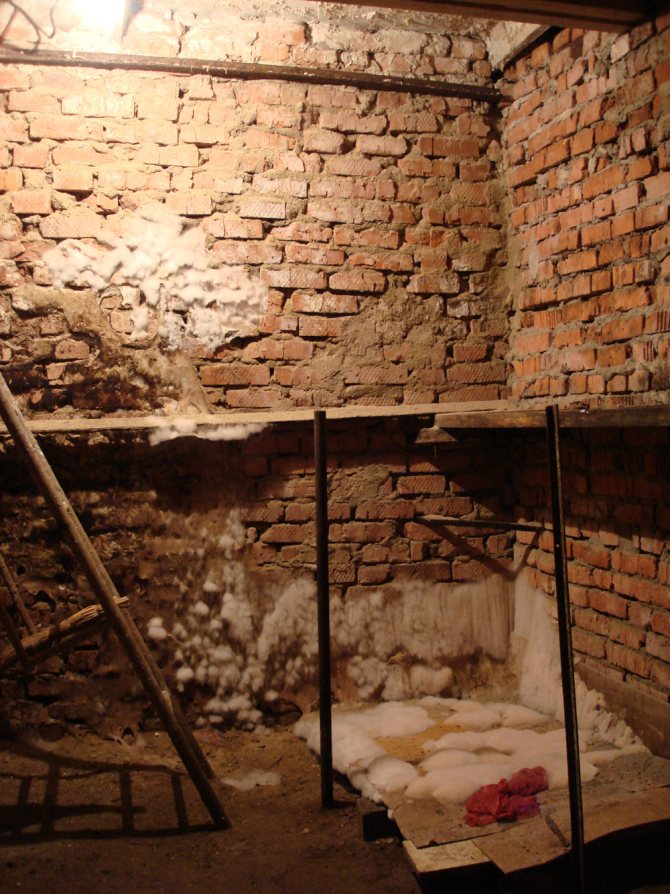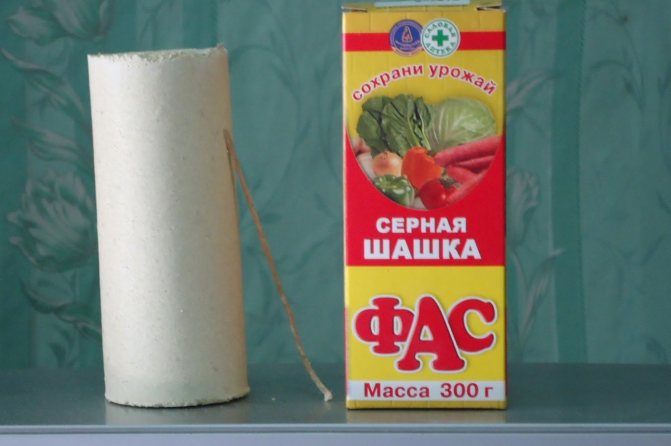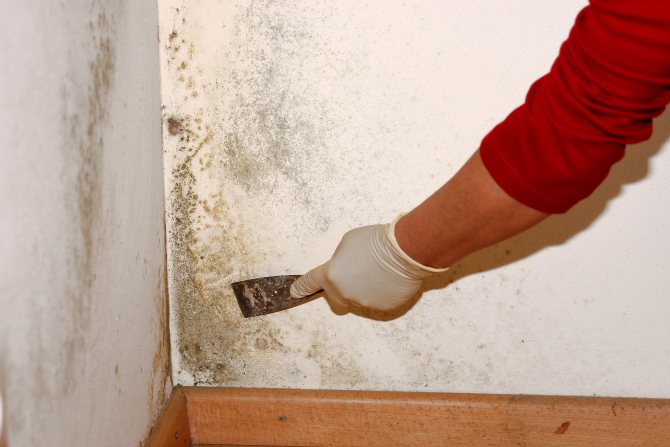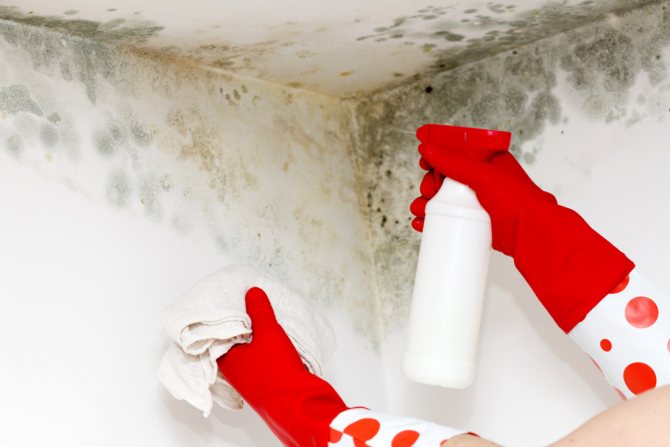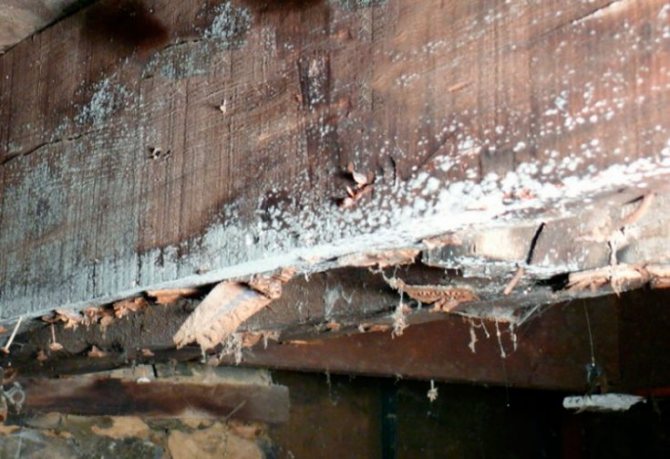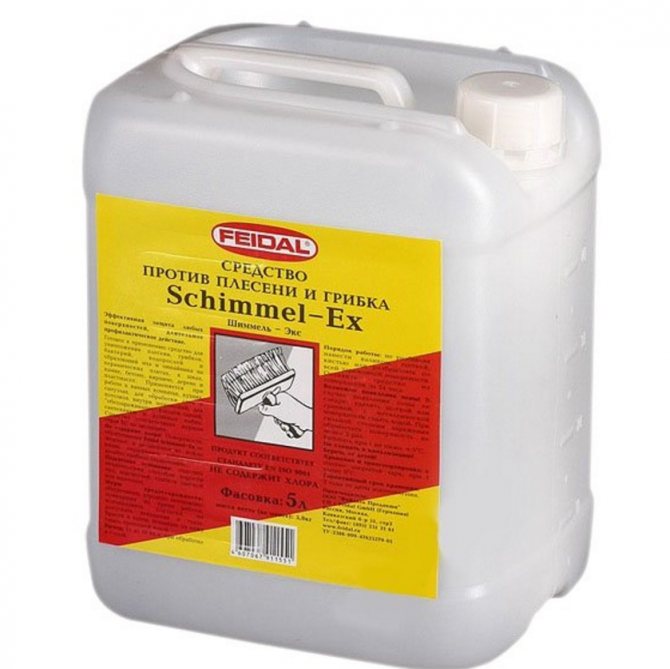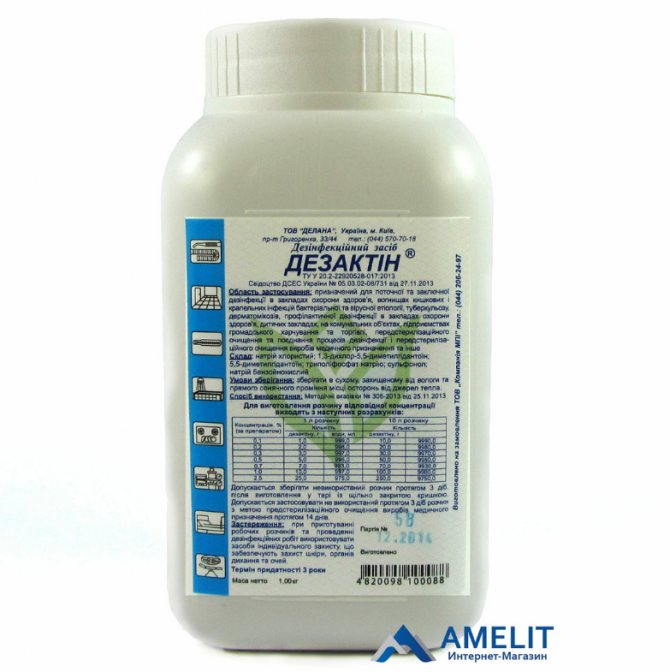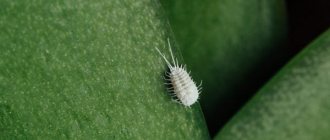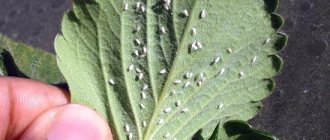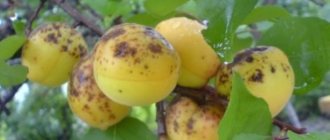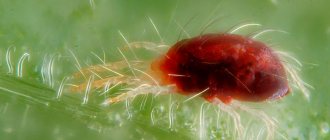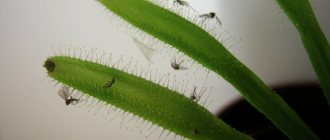Quite often, mold, similar to cotton wool, is found in the cellar. This is due to the fact that there is high humidity in the cellar and there is no normal ventilation. Many people do not pay attention to it, but in vain, since it can cause significant harm to human health.
In addition, there is a risk of mold spreading onto food. At the same time, it is capable of actively multiplying, reducing the shelf life of products or making them useless. If such mold is found in the cellar, then it is necessary to take all measures to destroy it. This article explains how to get rid of fungus properly and quickly.
Danger of spreading fungus
If a fungus has appeared in the basement, then it is necessary to immediately take measures to eliminate it, since it gives off numerous spores. Experts associate their impact with many diseases, including chronic respiratory diseases, migraines, allergies, irritability. Since the respiratory organs are not yet fully formed in children, mold has a greater effect on them.
Fungal spores are invisible to the human eye, which is their main danger. So, if black spots of mold appear on the ceiling or walls, then it is necessary to start the fight until the spread has reached colossal proportions. Often people turn to specialized services that quickly destroy the fungus in the basement. But, if this is not possible, then you can cope with the fungus on your own.
Fungus harm to human health
Many people do not pay attention to dark spots that quickly spread in basements, but their appearance is a signal of a serious danger to the residents of the house. The fungus quickly passes into food and releases toxic substances that enter the lungs through the respiratory tract and into the entire body through the skin. Mold causes many diseases: allergies, asthma, chronic rhinitis and bronchitis, severe headaches, kidney and liver diseases, internal bleeding. Therefore, immediately when the fungus appears, it is necessary to begin to actively fight it in order to remove the mold from the cellar as soon as possible.
If there is a small amount of mold or mildew
Microscopic spores invisible to the human eye are constantly present in the air, soil, on surrounding objects, plants, on the skin and hair of animals, as well as inside their bodies.
A person, without knowing it, is a distributor of fungal cells. Mycelium spores that get on clothes or shoes are transferred from the contaminated environment and settle in new places.
If the conditions for development are favorable, cells germinate, forming hyphae on the surface of objects, and then mycelium. Outwardly, it resembles spots, cotton wool, crust or jelly, depending on the type of fungus. Colorless or glow-in-the-dark varieties are known.
In this case, the easiest way is to use folk remedies that can least harm a person. But sometimes more powerful formulations have to be used.
Fire treatment
In this case, you can use a blowtorch or other available means. This is a mechanical method of removing mold, which will help to solve the problem only at the initial stage.After the mold has burned out, it is imperative to solve the problems that caused the appearance of hazardous particles.
In 80% of cases, this remedy helps to get rid of mold if the affected area is small. If small dots appear on the walls or ceiling, then you can "burn" them with ordinary table vinegar applied to a clean sponge. You can also dilute it in water in equal parts and rinse the affected surfaces thoroughly.
If the basement is seriously infected, a more powerful remedy can be prepared. For this:
- Pour half a glass of water into the container.
- Add 50 ml of vinegar and the same amount of hydrogen peroxide.
- We add 25 ml of boric acid.
- Slowly mix all the ingredients and heat the resulting mixture over low heat to 50-70 degrees.
- Immediately, while the mixture is warm, apply it to the affected areas of the concrete walls and ceiling.
- We are waiting for 15 minutes.
- We clean the surface with an old brush. We throw it out.
While this is a relatively complex recipe, it pays off.
Hydrogen peroxide
In this case, we will need the usual 3% hydrogen peroxide, which is sold in any pharmacy. Since it is already highly diluted, you do not need to dissolve the liquid in water. It is enough to apply peroxide on a soft sponge and walk it along the walls and ceiling.
Due to the fact that the composition contains only 3% hydrogen peroxide, such a product may not provide long-term results. For a more neglected situation, you can make a concentrated composition:
- We buy tablets called "Hydroperit" at the pharmacy.
- We dilute (one piece is enough) in water according to the instructions.
- We get a concentrated mixture that is applied to the areas affected by mold.
Lemon acid
This is a very effective method for killing mold. But if the lesions are large, then you will have to spend a lot since citric acid is expensive. In this regard, it is more often used at the initial stage of fungal development.
Helpful! This method is considered one of the safest for humans.
To prepare the solution, it is enough to dissolve 100 g of citric acid in a liter of water. After that, you need to apply the liquid to the foci of infection. The remaining mixture can be distributed in the corners (from there, mold often begins to grow). This method will allow you to get rid of not only the external signs of fungi, but also from the unpleasant odor.
Types of fungus and how to deal with them
Each type of mold has its own characteristics. Having understood them, you can quickly and easily eliminate the trouble.
Mold
Mastering concrete and stone, places treated with poor quality paint. It appears in blue, green, black colors. Contributes to the destruction of materials and decoration of the room - after the appearance of this type of mold, repairs are often required.
Blue mold
It settles mainly in wooden houses. Spores penetrate the tree, causing it to turn blue. It gets wet. The fungus provokes the appearance of new types of fungus in the tree.
Rotting fungus
Only the wooden structure can suffer from it. Its color changes to gray, the material becomes weak and loose.
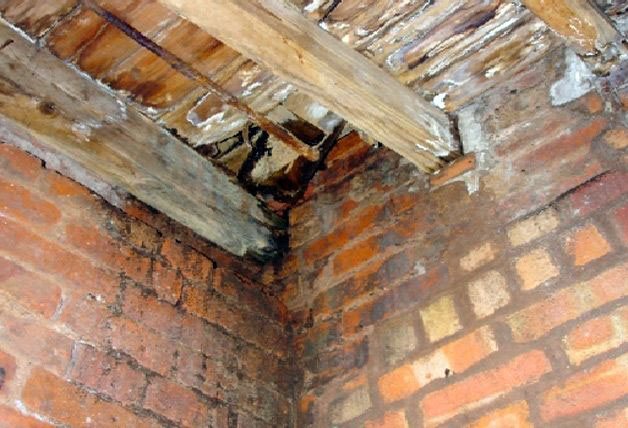
Even the most durable wood loses its properties. The danger of white fungus is that it can spread to neighboring rooms.
Mold control measures should be comprehensive. It is necessary:
- Completely empty the cellar of things. This will facilitate the processing of places where organisms are concentrated.
- Examine all furniture in the light, clean it from mold. If any wooden structure is badly damaged, it is better to replace it with a new one. All items can be treated with soapy water, then with an antifungal agent.
- Perform general cleaning in the room, dry it.
If you don't feel like messing around with folk remedies, you can buy an antibacterial agent at the pharmacy.When using it, you should follow the instructions exactly.
After processing the room with any means, it must be left to ventilate, then conditions must be created under which the fungus cannot revive again.
The causes of mold in basements
One of the most "popular" places for fungus to appear are basements, where little light and air enters. A humid microclimate, musty air, lack of ventilation and heating, the presence of cracks and poorly processed seams, leading to leakage of pipes, storage of spoiled products and low-quality wood are the reasons for the active reproduction of the fungus.
In such conditions, even a small amount of water that gets into the cellar causes the appearance of whole colonies of mold, which destroys building and finishing materials. Getting on the pipes, the fungus causes corrosion of the metal. Wood also rots and collapses, losing its strength. In the room, the ceiling can collapse and the floor fall.
The cellar and basement are storage rooms for the winter. There are comfortable conditions in which food can be stored for a long time. But these conditions are great for mold growth. Fungus is usually caused by:
- High temperature, which is over 20 degrees.
- Constant humidity.
- Poor seam insulation.
- Residual moisture due to materials used in construction.
- Poorly designed waterproofing or no waterproofing.
The main issue in the fight and prevention of mold is the implementation of proper ventilation and waterproofing.
We suggest that you familiarize yourself with: Folk remedy for fungus on the walls
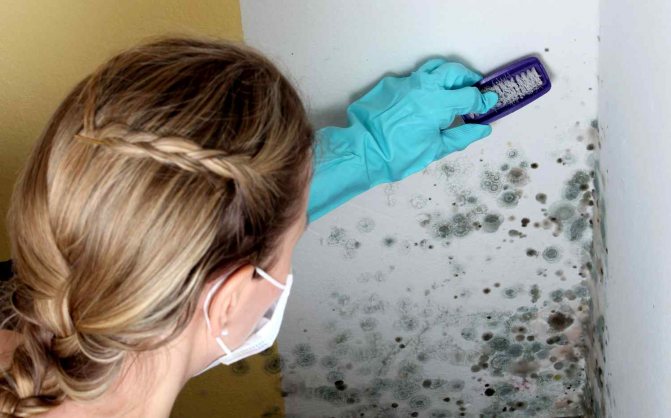

The first signs of fungus spreading in the basement are musty air, the presence of water droplets on the walls and ceiling, and mold.
Prevention of mold in the cellar
It is easier to prevent the appearance of the fungus than to try to remove it later. However, even prevention is not as simple as it might seem, especially considering that few people like to take care of the basement: usually it is a warehouse of various garbage or things that are rarely required.
Prevention methods:
- Make insulation. It is necessary to insulate the basement first of all from the outside, only internal insulation often does not work. You can also do the work for an already built house.
- Conduct a ventilation system. The point is mandatory: without air exchange, the fungus will still appear again.
- Make waterproofing. If there is a normally working ventilation system in the cellar, and it is insulated from the outside, then waterproofing is not a mandatory item. However, it is still recommended to make it, as an additional protection. Moreover, this can be done together with wall insulation.
- Installing a heat source. It is not necessary to draw a line here from the heating system: the simplest and cheapest electric heater, which can be switched on from a humidity or temperature sensor, will do.
- Regular visual inspection. The basement needs to be checked periodically. Attention should be paid to violations of the microclimate (accumulation of moisture, musty air) and deal with them when they are detected. You also need to inspect the surfaces for the appearance of mold, so that it can be noticed in time.
- Control by means of devices. We are talking about a moisture meter and a thermometer. Hang the cheapest measuring devices on the wall in the basement, and pay attention (at least once a week) to their readings.
- Correct storage. First of all, you need to properly store things that are most often susceptible to fungus (important for food and textiles). For example, food does not need to be stored right against the wall, but placed in boxes that are placed on racks.
The methods described above do not guarantee one hundred percent protection, but they seriously reduce the likelihood of fungal growth.
Conditions for the reproduction of the fungus
As you know, mold develops very intensively in the cellar. This is facilitated by ideal conditions:
- high humidity;
- positive temperature;
- the presence of organic matter.
Microorganisms can receive nutrition only by living at the very source of food. In a warm aquatic environment, food is much easier and faster absorbed by the surface of the hyphae. With a large size of organic molecules or their complex composition, mold releases enzymes that help break down substances and digest already small fragments.
In a cellar or basement, food for mold is:
- fresh vegetables and fruits;
- wooden structures;
- dust on concrete or brick walls;
- interior decoration made of organic materials.
The development of mold is facilitated by insufficient ventilation, freezing of walls with the formation of condensation, temporary flooding with melt water, leaks of upstream communications - everything that increases the humidity in the room.
Fungus in the underground of a wooden house
The peculiarity of the basement in a wooden house is the materials used.
Wood is the most natural building material, it is susceptible to a number of diseases - fungus, rotting, mold, etc. Under conditions of insufficient ventilation and humidity, the basement is quickly affected by infections. The smaller its area, the more difficult it is to make correct air exchange.
In this case, it is imperative to equip holes in the walls of the underground at a distance of at least 0.4 m from the ground. Due to the fact that they go out into the street, the outer openings are covered with nets from debris and small animals and insects.
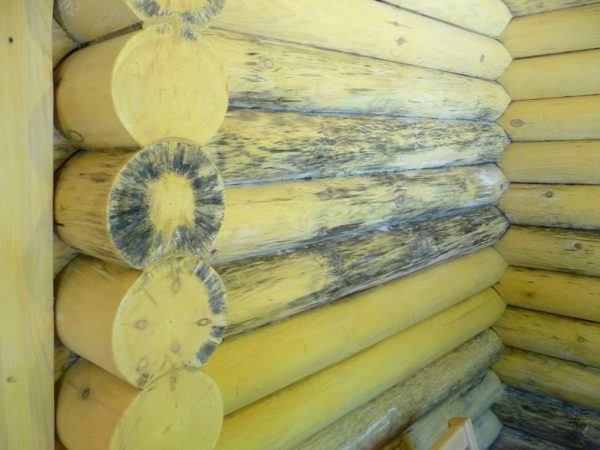

Working with chemicals in small rooms is very dangerous for human health. In such cases, alternative methods of struggle are sought.
- Sulfur bombs, the smoke of which disinfects the room;
- A solution of hydrochloric acid, but in a slightly modified form - ordinary coarse table salt is poured with it. The container should be taken ceramic or made of glass, placing it in the center of the room on the floor;
- Excellent absorbent - white moss powder. It is poured into containers and placed in the corners of the basement.
Drying underground in a wooden house using an electric fireplace is strongly discouraged due to the danger of fires and fires. A professional hairdryer with such a small size is also of little use.
Laying hot ceramic bricks around the perimeter would be optimal. They absorb moisture and can be heated an infinite number of times.
Varieties of fungus
The fungus is the oldest living organism in the world that can absorb the necessary substances for life from the environment. During their processing, the fungus is able to release toxic substances, carbon dioxide and ethers into the air, which give an unpleasant smell of mold.
In order to be able to qualitatively remove mold, it is necessary to understand its varieties.
Molds appear, as a rule, on finishing materials. They are spots with a different color, which can be green, brown, blue or black. Such fungi can contribute to the destruction of the finish, which will lead to the need for finishing work and more complex repairs.
Blue fungus is especially dangerous when wood is affected. Mold acquires its shade, eating into the structure of the wood, which increases the moisture content of the material and opens up access to other types of mold. Most often, such a change is observed when decorating cellars with pine trim.
Rotting fungi can be very different. When exposed to wood, they paint it gray, brown or white. This mold can destroy even the toughest material in as little as a month.
Danger of fungus to humans


Not many people know that a fungus, both directly and indirectly, can seriously affect a person's well-being. A floor infected with a fungus, sooner or later, will fail. As a result, you can get serious injuries. The same can be said for the ceiling, which can collapse. This is when it comes to timber structures. Mold can affect human health by:
- Direct contact with human skin.
- Through the human respiratory and circulatory system.
- As a result of eating foods affected by the fungus.
Many types of fungi are characterized by highly toxic spores. Mold multiplies very quickly: 1 square meter of a colony of fungi can throw up to 1 billion spores into the air. Under favorable conditions, they can begin to develop in the human body, which can lead to various diseases.
Mold contact can result in various consequences. For example:
- Dermatological lesions of various parts of the body, especially the skin, as a result of allergic reactions.
- The defeat of the upper respiratory tract, as a result of which nosebleeds, sinusitis, profuse rhinitis, and difficulty breathing are manifested.
- Manifestations of headaches and dizziness are possible.
- Malfunctions of the gastrointestinal tract with bouts of nausea or vomiting.
- Depletion of the body, manifestation of anemia.
Long-term contact of a person with mold can lead to disruptions in the functioning of the kidneys and liver, as well as to the occurrence of internal bleeding. Pulmonary emphysema is also possible. First of all, people with weakened immunity suffer from such contacts. As a rule, these are children and the elderly, as well as people suffering from fungal diseases.
It is very important to know that mold allergy can be diagnosed in any laboratory. If it is established that the cause of the allergy is a fungus, then you need to immediately take measures to detect and destroy it.
What types of fungus exist
More than 140 thousand species of mushrooms are known to man. Scientists have identified them as a separate kingdom due to the simultaneous similarity with plants and animals. Having a cellular structure like some, they carry out nutrition like others.
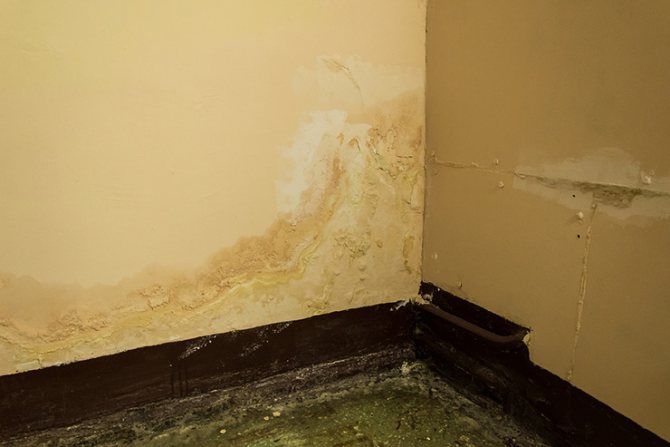

There are many types of fungus
Scientific facts and legends are embodied in the sensational film "Mold", where vivid plots twist around this mysterious phenomenon.
The fungus in the cellar is most often a representative of asco- or zygomycetes. These are very common types of microorganisms, the reproduction of which is possible both vegetatively (asexual) and sexually.
Various types of mold are classified as biodegradants. They destroy not only organic residues, but also damage building materials. Biological corrosion, as a result of which structures lose their aesthetic appearance and strength, occurs under the influence of substances released by microorganisms.
The tree changes color under the influence of the fungus. Blue, brown, pink, brown or yellow spots, rot and other wood defects appear. In a matter of weeks, mold can turn material into dust.
Various types of yeast often settle on food reserves - Mukor, Aspergillus, Fusarium and others. Products affected by mold should not be eaten. There is a real danger to health - poisoning, serious illness.
Types of mold
The most common varieties of mold in basements include:
- A blue fungus that reproduces mainly on wood.
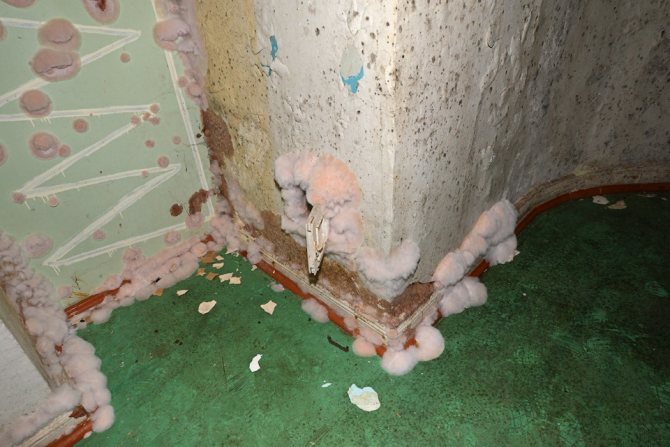

- Mold that appears on any surface that is not protected from moisture. It is a bloom of black, white, brown or blue. Digging deep into the material, this type of mold becomes dangerous for the entire finish of the cellar.
- A rotting fungus that also affects wood surfaces. It is divided into cotton-like white rot (it spreads especially actively and can quickly spread to other parts of the house), as well as brown and bacterial rot, which can destroy the material in a short time.
Fungal colonies and human health
White, black, yellow or brown mold in the cellar - why is such a neighborhood dangerous for a person? Is it worth spending time, effort and money to get rid of the fungus?
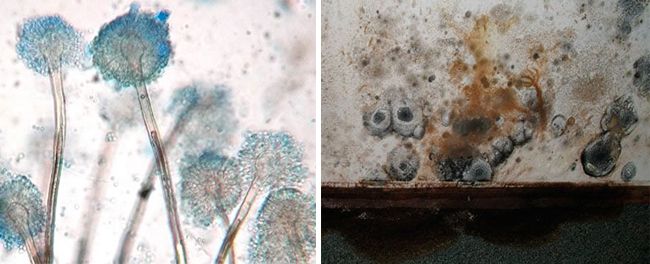

Scientists and doctors say that many types of mold are harmful to human health. Fungi release mycotoxins that affect the digestive tract, respiratory system, central nervous system, joints and blood vessels. The exception is cultivated species specially grown for specific purposes.
Inhalation or consumption of waste products of micromycetes and their spores with food causes serious diseases:
- children's diathesis;
- allergies;
- bronchial asthma;
- bronchitis;
- rhinitis;
- otitis media;
- mycotoxicosis;
- migraine;
- bleeding of blood vessels;
- anemia;
- heart rhythm disturbances;
- mold damage to organs;
- oncology.
Influence on a person
The fungus is capable of infecting and destroying not only premises. It is bad for people. In addition, it can spoil the food stored in the cellar.
Mold can affect humans directly through the respiratory system, skin and blood. Due to constant contact with the fungus, the following symptoms may develop:
- headaches;
- allergic skin rashes;
- runny nose, shortness of breath, nosebleeds;
- digestive disorders, nausea, vomiting;
- general weakness, exhaustion.
You can often even smell mildew. This is the smell of the spores that a person inhales through the nose.
As you can see, mold is very dangerous. Therefore, it is necessary to get rid of the fungus in the cellar immediately after detecting its first signs. There are effective methods to help eradicate this problem forever.
Disinfection
Disinfection of the cellar will help get rid of the fungus and prepare the room for high-quality waterproofing and ventilation. The work is carried out according to the following algorithm:
- Indoor cleaning. To do this, you need to take out all the racks, cabinets, chests and other pieces of furniture so that the room is completely empty.
- Cleaning the walls with a wire brush.
Important! The most careful action is necessary in places affected by mold. - Basement furniture is thoroughly dried in the fresh air at this time.
- After drying, the furniture is treated with a solution that disinfects against mold.
- It is very important to remember that if the cellar has an earthen floor, it is necessary to remove the top layer of it, in which there may be spores of the fungus, before starting treatment.
- For disinfection from fungus, the best remedy would be a sulfuric checker. The vapors of sulfur dioxide will quickly and effectively kill all remaining microorganisms, even in the most difficult to reach places.
- Before removing mold with sulfur, all ventilation openings must be blocked. After that, the sulfur is ignited and left in the room affected by the fungus, with the hatch closed for at least 10 hours. This time will be enough for the complete elimination of the fungus.
- After exposure to gas, it is necessary to thoroughly ventilate the room, and treat the walls and ceiling with slaked lime in order to avoid the reappearance of the fungus.
If the sulfur treatment from the fungus for some reason cannot be done, then the cleaned walls and ceiling can be treated with a solution of formalin, chlorine-type lime and water. This option also often acts as a preventive one.
Another way to treat mold is to treat the cellar surfaces with a mixture consisting of 1 kilogram of slaked lime, 100 grams of copper sulphate and two buckets of water. With this mixture, the walls and ceiling are carefully processed from a specialized sprayer.
We invite you to familiarize yourself with: Hammer paint for metal and the benefits of its use
To disinfect the furniture from the basement from the fungus, you can use a substance called deactin. It is diluted in water at room temperature and the required surfaces are treated with a ready-made product.
Important! In order to avoid negative effects on the body, this procedure is carried out only in the fresh air.
There is enough information on how and how to treat the cellar from mold and mildew on the Internet and in the media. It is important that the funds are not only effective, but also safe for humans. After all, it is supposed to store vegetables and fruits in the room, into which poisons can penetrate from the environment.
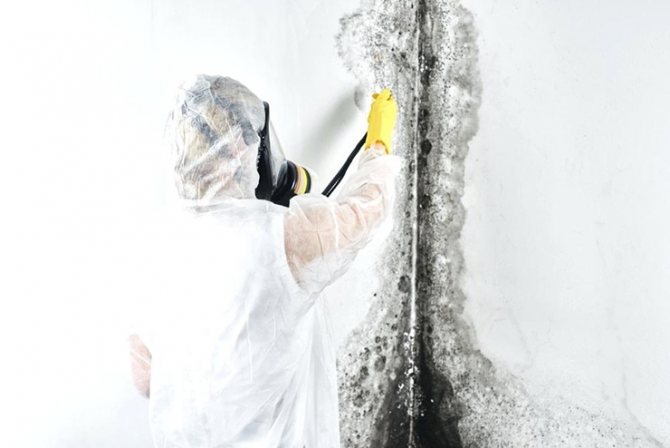

The safest are considered:
- chlorine-containing liquids, gels and pastes;
- slaked lime;
- copper sulfate;
- vinegar, citric or boric acid;
- hydrogen peroxide;
- fungicides.
Surfaces are washed or sprayed with solutions, taking precautions. All substances are corrosive, can cause burns to exposed areas of the body and respiratory system.
The burning of sulfuric bombs in a closed room with subsequent thorough ventilation, calcination of the walls at a temperature of 60 ° C with a gas burner are popular.
Replacing the top layer of an earthen floor with pests living there is a good way to cleanse the room from the damaging effects of mold. Most myceliums are located at a depth of 20-30 cm. The earth must be removed, and the base must be covered with clean sand.
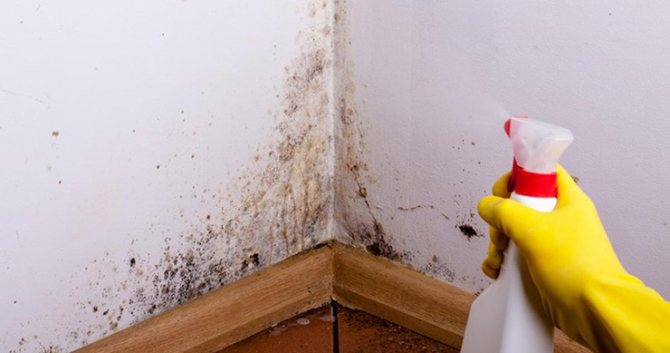

Don't forget about preventive measures
How to get rid of fungus underground in a private house
It is not enough to apply funds to contaminated surfaces; before such work, they should be carefully prepared beforehand. Including pay attention to waterproofing and ventilation systems.
Cleaning the premises
- They take out all the products, things, everything that is on the shelves. The shelves themselves are removed and taken out into the fresh air. The same procedures are carried out with containers and other reservoirs. If the basement floor is lined with boards, they are dismantled and also taken out;
- All objects and materials made of wood should be thoroughly dried in the sun in the fresh air. It is necessary to carry out such work on dry, clear days in summer. After drying, all surfaces must be disinfected with preparations in several layers. Even if they were processed, and this does not help, we get rid of such items;
- Metal structures, as well as containers and other tanks, are cleaned from rust, disinfected and applied with anti-corrosion impregnation;
- The concrete wall of the basement (or brick) is cleaned with a metal brush.
Before removing stains and cleaning the surface, remove all foci of rot and remove layers of plaster that have been infected.
If there is an earthen floor in the cellar, then you need to remove the top layer of soil, since it can be infected.
After preliminary procedures, disinfection begins with a whitewash brush and a mixture of lime and vitriol. You can use a spray bottle.
Waterproofing, treatment and wall covering
Since the main cause of mold and mildew in the basement is dampness, the waterproofing of the underground walls should be strengthened. This requires preliminary drying of the room. You can use a fireplace (electric). Also, basement processing can be done using an industrial hair dryer.
- Examine the walls, remove all crumbling elements, embroider the seams and voids in the surface, followed by their sealing;
- In case of deep defects, the cavities are filled with plaster or cement solutions;
- Apply a thin layer of putty on top;
- After the composition has dried, the walls are treated with an antifungal impregnation, not forgetting about the ceiling, and covered with waterproofing materials.
It is optimal to fill the floor with concrete, checking for voids. The waterproofing of its base will be performed by a drainage layer, which is equipped with preliminary laying of expanded clay.
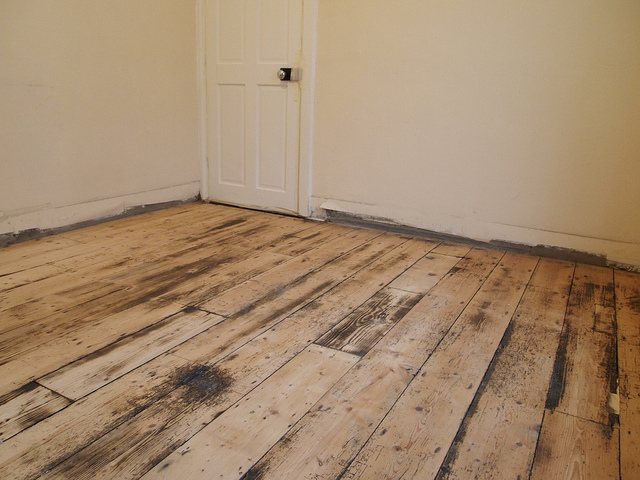

Ventilation
The ventilation system is equipped even during the construction of the house. As a rule, this is its natural appearance, supply and exhaust scheme.
If it cannot cope with humidity and air volumes, it is necessary to convert it into a forced one by installing special fans in the pipes, or lay a second row of pipes, on the floor and under the ceiling.
Alternatively, you can punch holes in the doors or make slots along the base of the perimeter, this will provide better air exchange.
What to do with the foundation if groundwater passes close
In some cases, dampness is caused by groundwater entering the basement at a high level of occurrence. If you do not equip external drainage systems that lower the water level in the soil, there will always be flooding in the basement.
The arrangement of such a system should be below the level of groundwater flow, carrying out layering from the structure. This will protect the walls and basement material of the house from dampness and fungus as a result.
Ways to fight fungus in the basement
Do not believe that concrete is resistant to such things. Mold can pass through microcracks and spread on the surface of the concrete, especially without affecting it. There are several factors that trigger the development of mold:
- Lack of ventilation. Combined with humid and warm air, this becomes an almost ideal environment for such particles.
- Insufficient access to daylight. Ultraviolet light prevents mold from growing.
- Condensation formation. Often, basement waterproofing is not performed at the proper level. Perhaps there is no blind area and groundwater is not drained efficiently enough.
- Long-term storage of products that have already begun to deteriorate and rot.
- The presence of wooden shelves and racks (for this type of room, it is better to use metal or plastic).
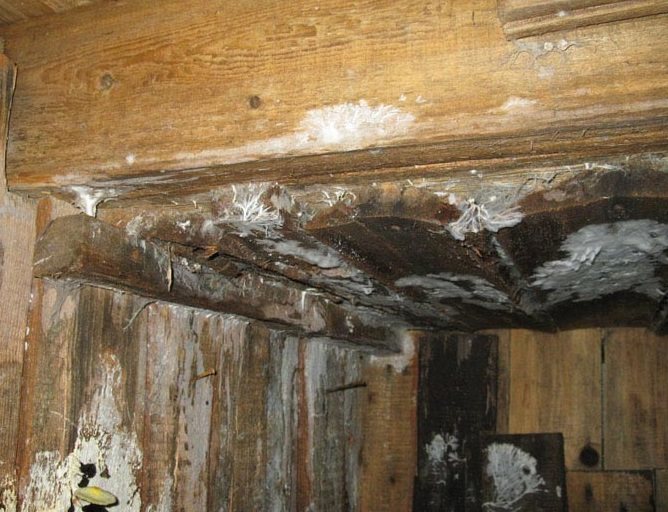

If the fungus and mold have already appeared, then the method of getting rid of them depends on the affected area. When the particles first appeared, you can do with simpler means.
It is not enough to just remove the mold. To get rid of it completely, you need to thoroughly disinfect all the corners and surfaces of the cellar, as well as the things stored in it.
The effectiveness and durability of mildew control depends on the right way to eliminate it. The most effective means are antiseptics, which have a disinfectant effect on the surface to be treated.
Above, methods of eliminating the fungus using disinfection with various means were considered, but other methods can also be used, which for some will be more affordable.
Whiteness is a versatile remedy that will help effectively combat the spread of fungus in the cellar and basement. In terms of its effect on mold, chlorine is somewhat similar to a sulfur stick. Before work, you need to take care of protective equipment, as the substance is very caustic. You will need rubber gloves and a respirator, as well as any protective clothing.
Getting rid of the fungus with chlorine-containing preparations is carried out in several stages. First of all, the surfaces are cleaned with a wire brush. This step is the same for all types of processing. Whiteness should be diluted with water in a ratio of 1 to 10.
Advice! A greater effect in eliminating the fungus will be achieved if a few tablespoons of ordinary salt are added to the solution.
The product is applied to all surfaces in the cellar. In places of the greatest accumulation of visible fungus, it is necessary to place cotton wool or a soft cloth soaked in the composition. Shelves and other furniture in the basement are also processed with the mixture. After the procedure, the room is thoroughly ventilated.
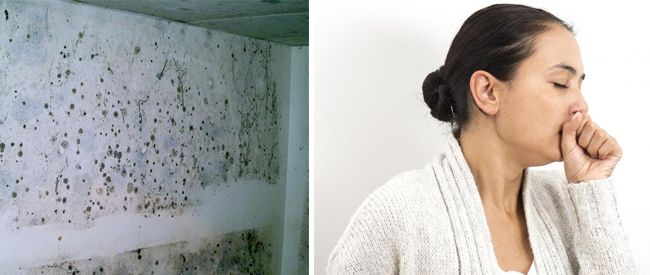

Boric acid is ideal for killing fungus. For greater efficiency, it is mixed with other related substances.Before work, you must mix water, vinegar, boric acid and hydrogen peroxide in a ratio of 4: 1: 1: 1. The solution is sprayed with a spray bottle on all surfaces and furniture affected by mold, and rubbed with a large piece of cotton wool. After the procedure, the basement must be ventilated, since this remedy for mold is quite poisonous in its composition.
This method of eliminating the fungus is suitable for those who are unable to use the previously named ones due to allergies or other reasons. You do not need to mix vodka with anything, just pour the alcoholic liquid into the spray bottle and spray it over the places where the mold lesions accumulate. In this case, the surface, again, is pre-treated with a metal brush. The tool is universal for mold and is suitable for any coating.
Advice! Vodka moistened with cotton wool can be applied to stained areas affected by the fungus so that the top layer does not begin to bubble.
How long, or better forever, to get rid of the fungus in the cellar? What can be done to destroy it?
The first is to make the mushroom colonies uncomfortable in an underground room, to deprive them of available food. This is possible by reducing air humidity, drying surfaces. Dry walls, floors and ceilings, full ventilation are powerful weapons in the fight against fungus.
The second measure is to remove the source of infection. If there is no constant flow of spores or parts of mycelium into the basement, the mold will disappear and never appear.
And in conclusion - getting rid of the colonies of the fungus with the help of folk remedies or antiseptic chemicals. They are effective not only against mold, but also other microorganisms that cause rotting of products, damage to building materials.
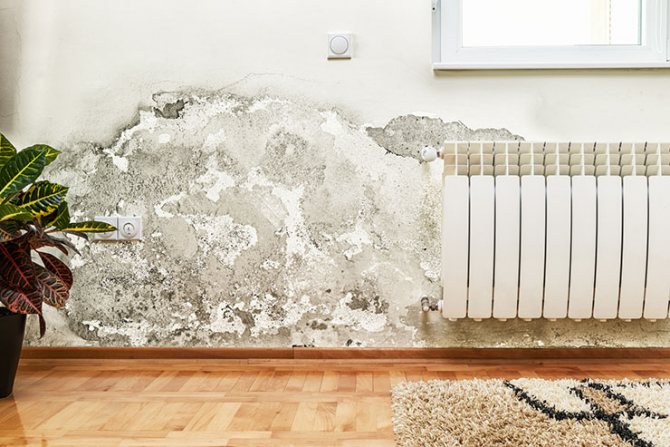

There are several ways to fight infection.
Before you start treating the cellar from mold and mildew, you need to plan the work and prepare in advance.
Folk remedies for mold
Folk remedies can compete in the effectiveness of chemicals.
We recommend reading:
Fridge odor remover
You need to take:
- acetic acid;
- water;
- copper sulfate.
All are mixed in proportions of 4: 20: 1. The resulting composition is used to process the cellar.
Boric acid is no less effective. It must be combined with vinegar and drill. The mixture will quickly penetrate all holes and kill the fungus.
There is another recipe for boric acid. Take 1 kg of salt, 100 ml of acid, 5 liters of hot water. Everything is mixed and sprayed on the walls.
Some owners use vodka. The undiluted drink is poured into a spray bottle, sprayed in areas of mold accumulation. They are pre-cleaned with a metal brush.
Good against mold and ammonia. Citric acid will also work. 100 ml of the concentrated substance is added to 1 liter of water, shaken thoroughly and sprayed over the cellar.
Waterproofing measures
When designing a basement at the stage of building a house, it is worth taking care of the correct waterproofing, which will become a barrier to the spread of mold. Here we are talking about external and internal waterproofing.
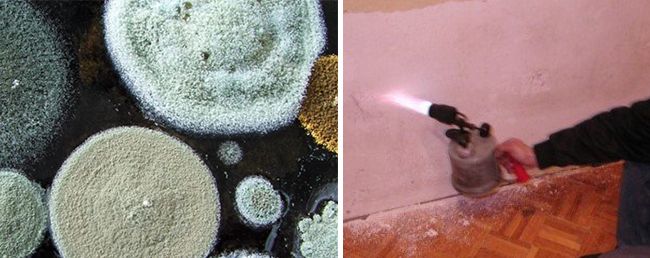

The first is a properly equipped drainage system, since usually the cause of fungus in the basement is the lack of a drainage system, blind area and drainage system on the porch and roof. If it is noticed that one or more elements from this list are missing, then you need to correct this gap.
We suggest you familiarize yourself with: How to properly steam an oak broom for a bath
After the work done to restore the external waterproofing, you can proceed to the internal one. For this, the cellar is carefully dried. With the help of a metal brush, the crumbling coating is removed from the ceiling and walls, and cracks are revealed. All of them are sealed with a putty mixture or cement mortar, depending on the size.After drying, it is necessary to treat the surfaces with an antifungal agent and coat the walls with the ceiling with a waterproofing material.
Advice! To increase the effectiveness of waterproofing, the walls in the cellar are additionally plastered.
An excellent method of waterproofing will be equipment in the basement of the wall made of moisture-proof material at a distance of at least 3 cm from the main one. Holes are drilled in the finished structure to allow air circulation.
The cause of the fungus in the basement can be the floor. Therefore, if it is concrete, it is necessary to close up all the cracks formed in time. It is better to cover the screed with expanded clay or other material that is resistant to moisture and will protect against mold.
If the listed methods did not help to get rid of the fungus in the basement, then only capital measures can solve the problem, which include prolonged heating of the affected areas with hot air, careful treatment of the fungus with potent chemicals and repairs, which must be carried out in full accordance with the rules that prevent mold formation.
Waterproofing - fighting moisture
If possible, it is recommended to organize basement waterproofing. It is necessary to worry about this even during the construction of a private house. It is recommended to waterproof the cellar both outside and inside. An external drainage system is meant, which will take all the moisture out of the basement of a private house. You should also fill in the blind area, install a storm sewer. All these important elements together will allow moisture to be removed from the basement and, as a result, completely eliminate the likelihood of fungus formation. After all, if the basement of a private house is dry, it will be very good.
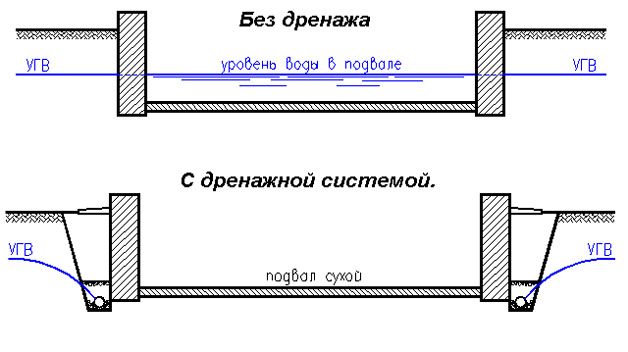

As for the internal waterproofing, then first of all it is necessary to drain the basement. So you can get rid of the old coating, which is already crumbling on the walls and ceiling. After that, take a metal brush and carefully clean out the cracks. All cracks must be covered with cement mortar or putty. The next step is to apply the antifungal mixture. It is important to thoroughly grease the walls and ceiling of the basement. When everything is dry, all surfaces are treated with waterproofing materials.
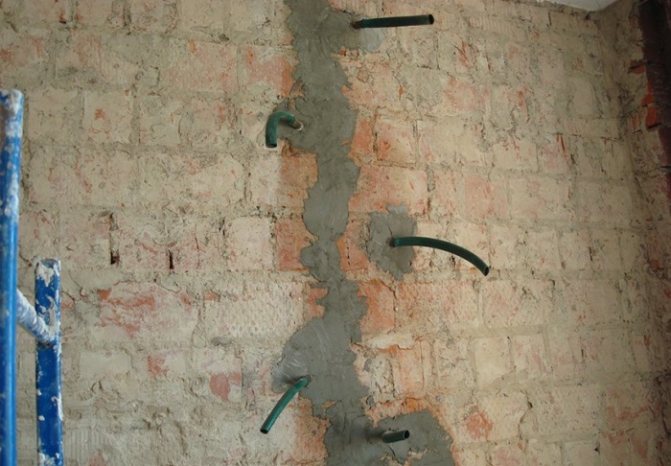

Advice! If in your area the groundwater is relatively high, then you can equip an additional wall made of moisture-resistant materials. To circulate air between the walls, drill through holes in the new one. By the way, the distance of the new wall from the old one should be about 30 mm.
In addition to walls and ceilings, floors should also be protected. Moisture will also show through it. Therefore, the entire operation described is also carried out when processing the floor in the cellar of a private house.
Premises preparation
Underground structures are constantly in a humid environment. If the space around the basement is not drained, there is no waterproofing, and the groundwater level is close to the floor surface, it is not surprising that the air in the room is saturated with water vapor.
When re-equipping an already built cellar, it is quite difficult to do voluminous construction work. It is necessary to dig around the perimeter of the basement wall, lay a drainage pipe, waterproof and insulate the surface, and backfill.
If this is not possible, then the walls of the basement from the inside are covered with penetrating agents - Penetron, Hydrochit. They create an impenetrable barrier in the concrete, preventing moisture from seeping through the walls.
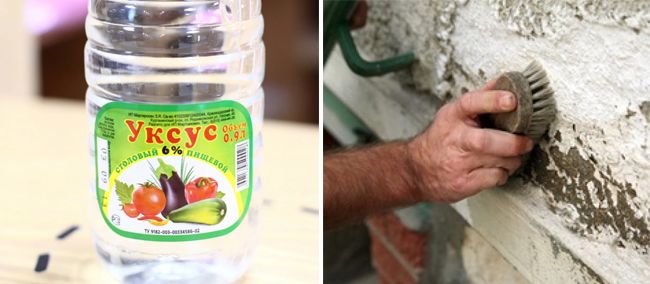

In practice, liquid glass, plaster with waterproofing additives are often used to protect the inner surfaces of basement walls. All joints are carefully sealed. It is important that moisture does not find even the smallest hole.
A good effect is given by additives to concrete that prevent the development of mold - Biolin and its analogues. In our country, this is not yet widespread, but materials can be ordered via the Internet.
It is imperative to make a drainage from the roof surface, insulate the blind area and basement.
Before processing the cellar, they take out everything that is possible from the basement from mold. Rinse racks, furniture and utensils with detergents or vinegar, and dry for two weeks in the sun.
What to do first
First of all, it is necessary to remove all sources of water penetration into the cellar. If you adjust ventilation, the air exchange system in it will return to normal, as will the humidity. All that remains is to remove the fungus from the surfaces.
Excellent preventive measures against mold are:
- periodic ventilation of the room (once every quarter of an hour);
- development of an integrated ventilation system;
- diverting two pipes from the cellar;
- punching holes in or under the door;
- elimination of cracks through which moisture can penetrate;
- covering the walls with moisture-proof products.
To prevent the air in the room from being too humid, you can heat it up from time to time. A heater or heated bricks spaced evenly around the perimeter will do. An excellent anti-moisture agent is white moss or vessels with slaked lime.
Mold does not tolerate high temperatures, so it can be removed with a burner. All surfaces are treated with it. This method is not suitable for wooden rooms.
Contributing to the growth of mold and mildew
So that in the future there is no question of how to get rid of the fungus, and it was necessary to constantly disinfect, it is necessary to take preventive measures on time. To do this, the cellar must be periodically well dried and ventilated. It is best to do this in the summer when the air is dry enough.
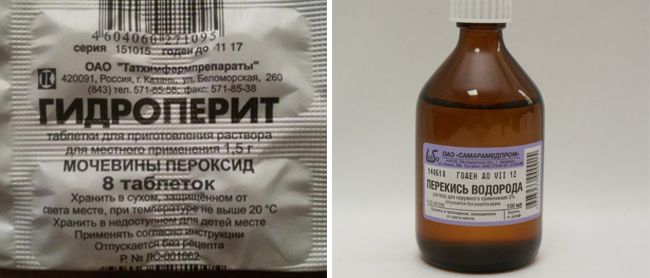

Depending on the humidity in the cellar, drying can take several days or even weeks. At this time, the racks are treated with soapy water and laid out in the place where direct sunlight falls. After they are completely dry, the wooden elements are coated with antifungal agents that prevent the development of mold.
The dried cellar is also treated with antifungal mixtures and dries well again. If there is an earthen floor in the basement, then it should be watered with a solution of water and copper sulfate. For areas where vegetables are stored, a mixture of sand and lime is poured onto the floor.
After the work has been done, racks can be brought into the cellar and supplies can be brought in.
Periodically dry the cellar and in winter, using a heater. There is no need to move racks and cabinets close to the walls in order to exclude the formation of condensation on surfaces, and as a result of mold. It is imperative to ensure that the containers with liquid that are located in the cellar are tightly closed with lids.
Advice! To improve ventilation, you can arrange two pipes in the cellar, one of which is located at the ceiling, and the other at the floor. Thus, the air will constantly circulate inside the room, which will make it difficult for the fungus to appear.
Why do fungi and mold form?
Basement mold never grows for no reason. Here are some typical reasons:
- Missing or clogged ventilation systems. If there is not enough fresh air in the basement, it will contribute to the formation of mold.
- High air humidity, condensation. This factor is a consequence of the first reason.
- Poor air circulation in the cellar.
- Rotten vegetables, fruits and other foods. Spoiled foods are the source of this scourge. Spores quickly spread in the basement to walls, floors, and ceilings.
- The presence of wood products infected with fungus.
Related article: Features of liquid plastic and products under its name
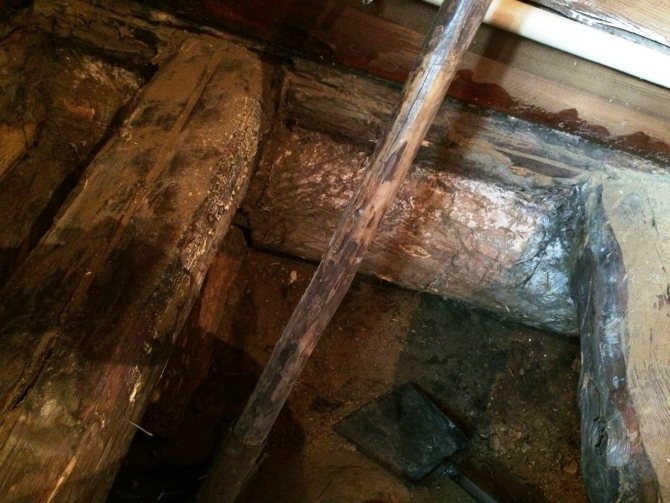

Preventive recommendations
To prevent mold in the cellar from becoming a permanent tenant, preventive measures need to be taken:
- arrange good natural or forced ventilation;
- treat wooden structures with antiseptic impregnations;
- do not store vegetables or fruits affected by the fungus;
- use quartz or bactericidal lamps;
- at the end of summer, carry out regular disinfecting treatments and airing.
No matter how difficult it is, it is necessary to get rid of mold in the cellar. This will help preserve the health of family members, reduce repair costs and extend the life of the premises.
How to remove mold from a tree in a basement
It is necessary to remove the fungus from wooden surfaces as early as possible, because it is no longer possible to remove deeply ingrained mold: it spoils the material very quickly. Before disinfection, the tree is cleaned with a knife or brush (the removed spoiled material must be burned), then the affected area is washed with a detergent. Mold treatment is carried out according to the instructions using a special wood preservative, which can be bought at the store. It is best to disinfect the material with chemicals outdoors. There are also natural antibacterial substances that perfectly remove fungus: vinegar, borax, hydrogen peroxide, pine and tea tree oil, drying oil.
We recommend:
How to switch windows to winter mode yourself - instructions
Harm to health - myth or reality
Spores grow and multiply actively, moving with the help of air and damaging materials and structural tightness. If it smells musty, then it is a fungus, namely the breakdown products of bacteria such as proteins, cell wall particles (glucans) and volatile organic compounds.
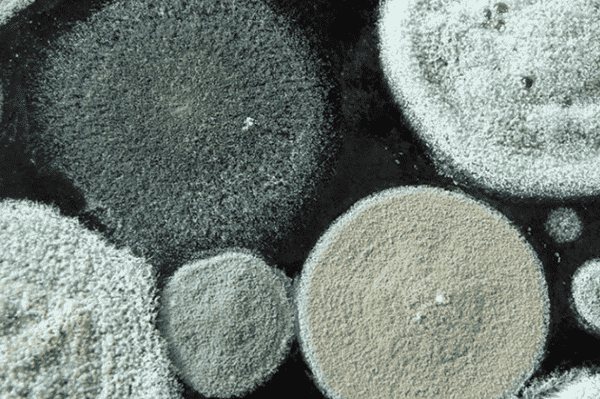

The fungus can hide from the human eye, but the smell will immediately betray its presence. Having found such a problem, you should immediately start processing the basement.
Fungus is not only disgusting and unaesthetic, it can also lead to health problems.
It produces allergens and irritants that lead to allergic substances. Some of its forms release mycotoxins that are hazardous to health. Inhaling spores after a while, the child and the adult will have symptoms of hay fever, sneezing, runny nose, eyes will turn red when entering the room, dermatitis (skin rash).
Allergic reactions can appear immediately or develop gradually. They can cause asthma attacks.
In addition, spores can irritate the eyes, skin, nose, throat and lungs.
Research on mold and its effects on human health is ongoing, but has already identified several diseases that fungus can cause.
These include:
- Infections. Frequent basement visits increase the risk of bronchitis and respiratory infections, but this theory has not been proven. Because of this, bronchopulmonary aspergillosis and thrush develop.
- Pulmonary bleeding. In the 1990s, several children in Cleveland developed pulmonary hemorrhage. One of these children died. Preliminary studies have identified the effects of mold, in particular mycotoxins from the black species.
- Hair loss. This symptom does not appear immediately. Hair begins to fall out 3–6 months after the appearance of the fungus, when it is already actively multiplying and producing dangerous toxic substances.
- Households often have headaches. They suffer from psychological depression and chronic fatigue.
The fungus also acts to suppress the immune system. The person feels overwhelmed. The disease does not have time to retreat, as new symptoms appear.
This is why it is so important to get rid of mold in your basement as soon as it is discovered, rather than waiting for the right moment or warm weather.
A complex approach
To get rid of the fungus, an integrated approach is used:
Preparing the premises and freeing up space. All things from the cellar must be removed.They take out furniture, shelving and other unnecessary items. Food stored in the basement is inspected for the presence of fungus.
Important: If fungus has appeared on the furniture, it is more convenient to clean it outside. It is better to throw away wooden structures with a fungus.
The earthen floor in the cellar (if any) is cleaned by removing up to 20 cm of the top layer. Since fungi take root deeply, removing the top layer of soil on the floor is necessary.
When fighting mold, experts advise using antiseptics with antibacterial and antifungal effects.
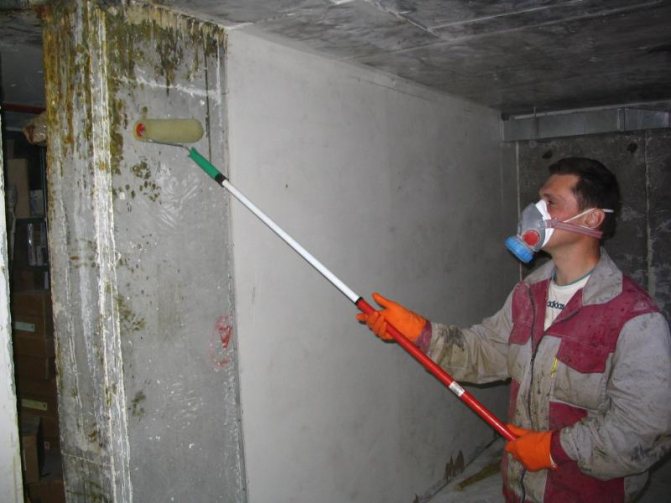

Traditional methods:
- Ammonia.
- Treatment with whiteness or other chlorine-containing agents.
- High concentration of citric acid.
- Boric acid with salt.
- Burner.
- Sulfuric checker.
- Lime.
- Copper sulfate.
Important: after processing of any kind, you need to leave the room and ventilate. As soon as the cellar wears out, conditions are created that will not allow the new spread of the fungus.
If the lesion is large enough
Mold develops quickly, and sometimes we do not go into the basement for a long time. If the infection has spread along the walls and ceiling, then the following remedies should be used.
Chlorine
This is a heavier artillery that will help get rid of large areas of infestation. But, it should be borne in mind that chlorine fumes are also dangerous for humans, so you need to work in a mask, gloves and be sure to take care of good ventilation in the room.
Any chlorine-containing product is suitable for processing. For example, the cheapest option is "Whiteness". Someone uses a concentrate of this product, and some are diluted with water in a 1: 2 ratio.
Cleaning is done as follows:
- We clean the affected area from mold and other infections with an iron brush or coarse sandpaper.
- We apply a chlorine-containing composition to a dishwashing sponge and thoroughly wipe the walls with it.
- We repeat the treatment several times so that the composition can penetrate deeper.
Helpful! When using chlorine, it is not recommended to use a spray bottle.
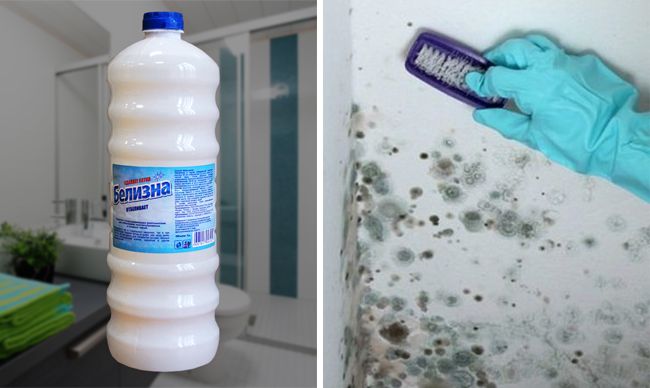

After that, you need to ventilate the room for several days. The smell of chlorine is very pungent, so you should wait until it completely evaporates. As a rule, if mold appears after this, then after a longer period of time.
Boric acid
This product is most effective against white mold. To prepare a cleaning solution, mix 1 kg of salt and a bag of boric acid (100 g) in 0.5 buckets of water. All components must dissolve well. After that, the composition is poured into a spray bottle and the surfaces are treated.
Copper sulfate and lime
In this case, you will need 100 g of vitriol and 1 kg of quicklime, which are mixed into a whitewash solution. To do this, vitriol is first added to a bucket of water and mixed. After that, we introduce lime. At the next stage, it is enough to distribute the product along the walls and ceiling.
If black mold has started in the concrete basement, then more vitriol can be added (300 g). For pinpoint lesions, dilute it in 3 liters of water. Such a concentrate of vitriol will quickly get rid of the infection.
It is not necessary to add lime. But, it gives the mixture the necessary adhesion. Therefore, the finished composition will stay on the walls longer. It is recommended to process it once a year, before the onset of the warm season.
Hydrochloric acid
This method cannot be called safe in any way, but if the mold continues to grow actively, then there is nowhere to go.
Helpful! You can only work in a respirator, goggles and protective clothing.
For processing, a solution is used, not a concentrate. The product can be diluted in different ratios, therefore, before using hydrochloric acid, it is imperative to read the instructions for the purchased composition. The product is applied to all surfaces (except zinc), and not only to foci of mold and mildew.
Specialized tools
Such compositions perform two functions at once: they effectively get rid of mold and mildew, and also prevent their further development. As a rule, the products are produced in the form of deep penetration primers.
The most popular are:
- ArmMix Biocide Gel. Suitable for processing concrete and stone. It is usually sold in cans of 1 liter as a concentrate, which is diluted in a 1: 5 ratio. Thus, one container is enough for a large area. Consumption is approximately 150-300 ml per "square". The product costs about 330 rubles per canister. The product is odorless, does not contain chlorine and other hazardous components.
- Olimp Stop Mold. It is an antiseptic that destroys mold and mildew, but is completely safe for humans and pets. It is free of toxins, chlorine and other things. It is used for both wood and concrete surfaces. Only in the second case does not impregnation play a role, but a means for removal. Liquid consumption 200-250 ml per m2. The funds are usually sold in five-liter canisters, 480 rubles each. But you can find a smaller volume.
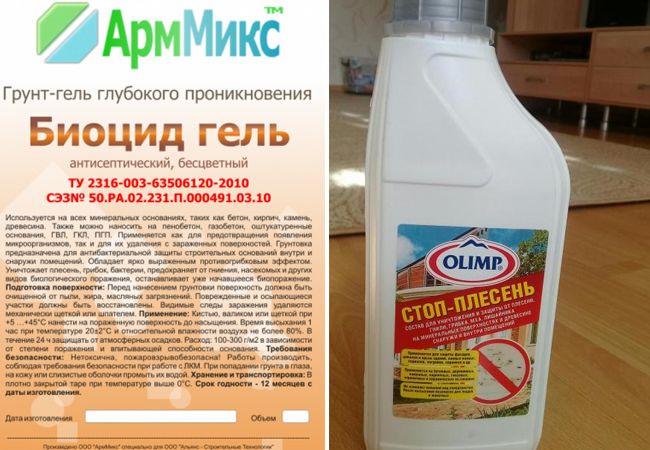

- Neomid Bio. This is another safe concentrate sold in convenient 0.5L bottles with a dispenser. It costs about 470 rubles. You need to breed strictly according to the instructions. Otherwise, there will be no effective result.
Why does it appear in the basement?
The basement, ground floor and cellar are the places where molds appear and multiply most often. The reasons for the appearance of mold in these places are highlighted:
- In summer, the temperature in the basement rarely exceeds 5 degrees. The difference in temperature outside and in the basement is the main reason for moisture condensation on the ceiling and walls. It is in such an environment with a humidity of 80% that mold appears.
- Due to poor ventilation, the air stagnates (the smell of dampness, musty air indicate this). Air of this quality provides an environment for mold growth.
- The temperature drop is felt more strongly in the absence of waterproofing and insulation. This causes moisture to condense more strongly.
- The fungus forms in a dimly lit or dark room.
Foods in the cellar or wooden items that have active spores contribute to the growth of the fungus.
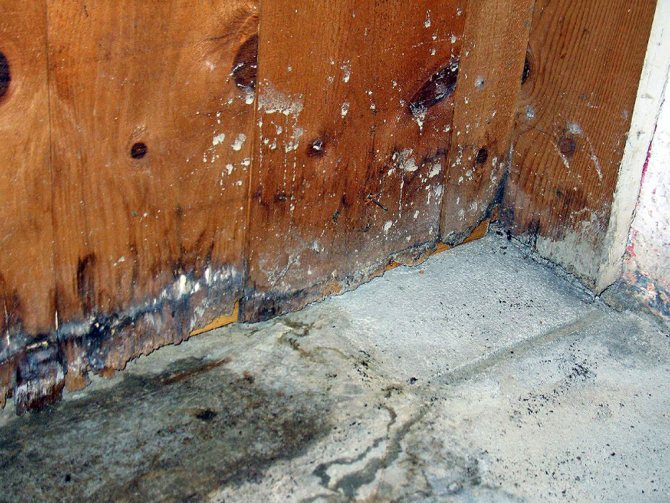

Due to the above reasons, the following types of fungi appear:
- Blue fungus. Dangerous for wooden things, as it deeply affects the structure of wood. The tree is painted blue. The fungus increases humidity and contributes to the development of other types of mold.
- Black mold. It originates on concrete and stone surfaces, as well as on those treated with poor quality paint. Black mold also affects food.
- White mold grows on cellar walls and food. Spores cause allergies, impair lung health - that's what white mold in your basement can do.
- Other types, the list is not exhaustive.
In addition to white, black and blue mold, a rotting fungus is secreted, which covers wood surfaces and is divided into types:
- Brown rot that destroys wood planks.
- White rot, damages structure.
- Bacterial stains gray and reduces strength.
Important: you need to eliminate the cause of the mold. Otherwise, an unfavorable factor will create conditions for the appearance of mold again.

